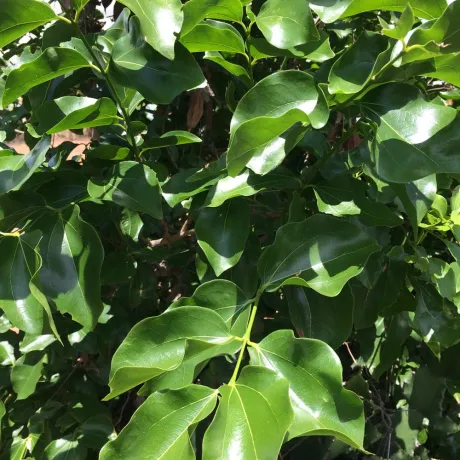‘Karaskara’ is mentioned as a tree available near townships. But its identity with nux-vomica is doubtful. Similarly, Vishamushtika is mentioned by Sushruta in the SurasŒdi gana. However it is not correct to identify the same with S. nux-vomica. Dalhana in this context described it as Raja Nimba. Review of literature indicates that Brihat Trayi texts and Dhanvantari Nighantu did not mention Vishatinduka or Kupilu. Sodhala denoted it as Vishatinduka while Bhavamishra described it as Kœkatinduka or Kupilu. Kaiyadeva quoted a drug Vi¦amu¦¢I which may be nux-vomica according to the author. RajaNighantu described five kinds of Vishamushti viz., Vishamushti, Kesamushti, Sumushti, Anumushtika and Kshupadoni.
Different Varieties– In ethnomedicine other species of the same genus are in vogue in Telangana area of Andhra Pradesh. The author noticed, that these species are being used in the name of different kinds of ‘Mushini’.
- cinnamomifolia (S. wallichiana steud. Ex DC. Or S. colubrina Linn. Or S. malaccensis)- root bark extract showed muscle-relaxant activity, is one of the other species in vogue.
Botanical Description–
An evergreen glabrous tree. Leaves– ovate, 5-nerved, glabrous, shining, obtuse. Flowers– greenish-white, borne on terminal pubescent pendenculate, corymbose cymes. Fruits– large, about 4 cm diameter, globose berries, yellow when ripe. Seeds– many, about 1.25 cm diameter discoid. Flowers during March-April and fruits ripen during winter.
Distribution– Throughout tropical India, Uttar Pradesh, Bihar, Orrissa and West Bengal, ascending upto an altitude of 1350 m.
Major Chemical Constituents–
Brucine, strychnine and vomicine; Kajine & novacine (N-methyl pseudobrucine); strychnine & isostrychine; Cuchiloside, loganic acid etc.
Part Used– Seeds, root bark.
Dosage– Powder 60-250 mg.
Research–
(1) Strychine showed remarkable negative chronotropic activity on frog isolated heart and guinea pig atria (J. Pharm. Pharmacol. 1970, 22, 380).
(2) Strychnine (50 mg/kg S.C.) increased level of acetylcholine in spinal cord and sustained convulsions in frog heart (Brit. J. Pharmacol, 1972, 45, 173).
(3) Strychnine (1.0 to 100.0 m) inhibited nicotinic stimulation of catecholamine release from bovine cultured adrenal chromaffine cells in concentration-dependent manner, it also inhibited nicotine-induced membrane depolarization and increase intracellular 2+ Ca++ concentration. Results suggest that strychnine interacts with agonist binding site of nicotinic acetylcholine receptors in chromaffine cells, thus exerting pharmacological effect independent of glycine receptor (Brit. J. Pharmacol. 1994, 113, 471).




Reviews
There are no reviews yet.